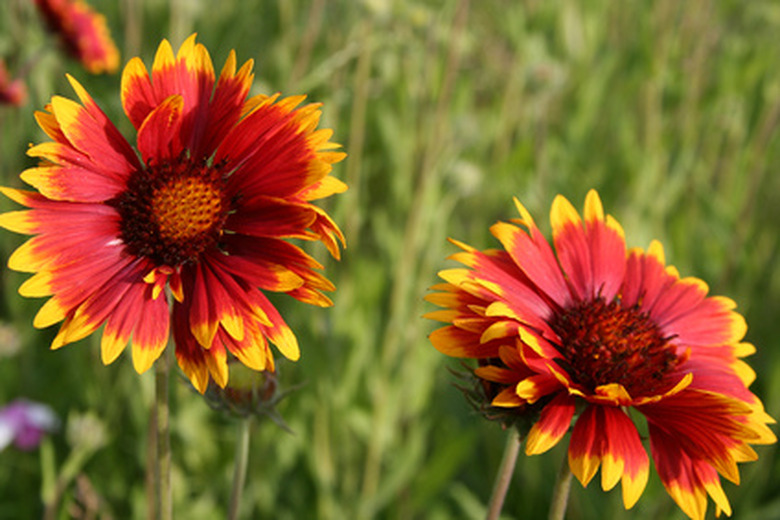How To Preserve Flowers Using Glycerin
Preserved flowers provide graceful reminders of summer blooms. Most preservation methods dry flowers, but preservation with glycerin replaces the water in the plant with a compound that maintains the supple texture of foliage and blooms. Glycerin is a more expensive choice for preserving plants and is reserved for materials where other methods fall short. It excels in preserving foliage and large or delicate flowers like hydrangea or bells of Ireland. Since glycerin-preserved foliage and plants fade, cake coloring, which contains glycerin and food colors, is often used to maintain natural hues.
Step 1
Cut flower stems up to 6-inches longer than you want the finished stem, using garden shears. Using your fingers, strip leaves from the lower part of the stem, leaving only a few at the top. Remove all leaves if you plan to wrap the stem with florist's tape. Store prepared stems in plastic bags in a refrigerator.
- Preserved flowers provide graceful reminders of summer blooms.
- Most preservation methods dry flowers, but preservation with glycerin replaces the water in the plant with a compound that maintains the supple texture of foliage and blooms.
Step 2
Smash up to 6 inches from the bottom of the stem with a mallet or hammer. You're laying open the phloem, a set of channels that, like veins, circulate nutrients through the plant. In order to keep the damaged phloem completely open, keep the prepared stems in a vase of hot water while you prepare the glycerin solution.
Step 3
Boil a quart of water, then allow it to cool to between 150 degrees F and 180 degrees F. Fill a pitcher or carton two-thirds full with the water. Add up to 2 cups of liquid glycerin (available at craft stores or pharmacies) to fill the receptacle within a few inches of the top.
Step 4
Plunge the stems into the glycerin solution. Mix the solution by swishing it around with the stems or a long spoon. Do not crowd stems; use more pitchers or cartons to give foliage and blooms plenty of room.
- Smash up to 6 inches from the bottom of the stem with a mallet or hammer.
- Add up to 2 cups of liquid glycerin (available at craft stores or pharmacies) to fill the receptacle within a few inches of the top.
Step 5
Allow stems to take up the solution for two to six weeks, depending on the size of the bloom, amount of foliage and length of stem. Add water to keep liquid at the same level; if soaking for more than two weeks, add a three-part-to-one-part mixture of water and glycerin to fill. When the flowers are completely preserved, they will have a rubbery feel but be completely pliable. Bells of Ireland, for example, may be ready in a week or two, but large or thick blooms like hydrangea or substantial ones like roses may take three weeks. Flowers with foliage attached to the stem will take longest; the glycerin must work its way up the stem and fill all of the plant cells.
Tip
Cut flowers in the morning; plants slow their respiration in the afternoons. Use a more diluted beginning solution for delicate flowers or foliage—up to three parts of water to one part of glycerin. Add a few drops of bleach or rubbing alcohol to the glycerin solution to keep mold from forming on flower stalks during soaks. Add a few drops of green coloring as the flower becomes pliable if foliage begins to turn brown. Pull the stems out as soon as the leaves absorb the green coloring. Cut down soaking time and browning by removing all foliage and leaving only stubby whole stems. Flowers without foliage may take as little as a few days to two weeks to finish. Make stems with florist's wires wrapped with tape; you can also tuck a few preserved leaves into the stem as you wrap it. If blooms are limp after soaking with glycerin, hang them upside-down for a few days to a week until petals stand up the way you want.
Warning
Use only early-bloom flowers from plants; flowers picked in late summer or early fall when the leaves begin to turn will not absorb glycerin efficiently.
Things Needed
- Garden shears
- Plastic bags
- Hammer or mallet
- Vase
- Hot water
- Pot
- Heat-proof pitcher or tall quart milk carton
- 2 cups liquid glycerin
- Long spoon (optional)
- Bleach or rubbing alcohol
- Gel (cake) green food coloring
- Florist's wire
- Florist's tape
